FEATURES|COLUMNS|The Shugendo Diaries
Connecting the Past and Present of Shugendo – The Revival of Japan’s Ancient Mountain Ascetic Tradition, Part Three
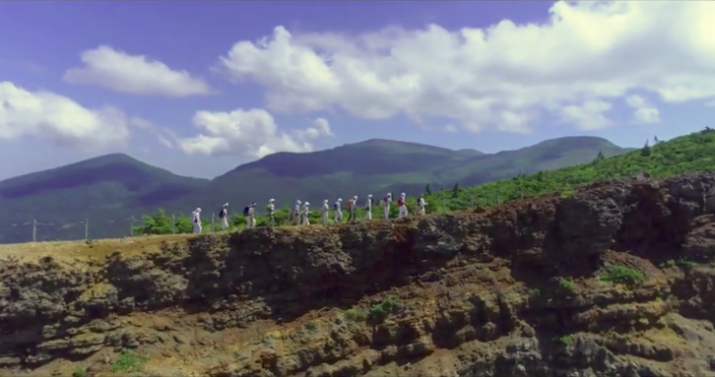 The first official pilgrimage along the Zao Kodo after the beginning of the Shugendo revival on Mount Zao. Image courtesy of Zao Kodo Kai
The first official pilgrimage along the Zao Kodo after the beginning of the Shugendo revival on Mount Zao. Image courtesy of Zao Kodo KaiZao is the name of a mountain in the north of Japan and also the name of a Shugendo deity: Zao Gongen. However, the locals of the Mount Zao area did not know about this connection until recently, when they began to rediscover their Shugendo past.
Mount Zao used to be a site for religious pilgrimages where Shugendo was practiced. Place names, old stone monuments, and small shrines and temples hint at the previously flourishing pilgrimage tradition that possibly lasted for more than 1,000 years. It had been all but forgotten during the last century.
This article is an account of the first stage of the Shugendo revival on Mount Zao, compiled from information kindly provided by Ryounin Tatsumi, the head monk of Sakuramotobou temple. The author thanks Mr. Tatsumi and the members of the Zao Kodo Kai for allowing us to make this information public.
Situating Mount Zao
Mount Zao is a group of volcanoes on the border between Yamagata Prefecture and Miyagi Prefecture in the Tohoku region (the area north of Tokyo). The mountain range is divided into North, Middle and South Zao. The Middle Zao range features bare volcanic mountain peaks and flat expanses of volcanic ash. The North and South of Zao’s peaks are covered in thick forest. Since 1963, the Zao mountain range has been a Quasi-National Park.
Its highest peak, Mount Kumano (in reference to the sacred site of the Kumano Sanzan on the Kii Peninsula), rises to an elevation of 1,841 meters and overlooks the Okama, a mysterious crater lake with emerald green water.
At the base of Mount Zao on the Yamagata Prefecture side lies Zao Onsen, and on the Miyagi Prefecture side lies Togatta Onsen. Both are hot spring villages and popular tourist destinations for trekking in summer and for skiing in winter. The Zao Echo Line, a scenic driving route, cuts through the Zao mountains and connects the two hot spring villages. The Zao Highline, a branch road, leads from the Echo Line directly to the Okama. Visitors nowadays drive to come here.
The Zao-Yoshino personal connection
The beginning of the Zao Shugendo revival might lie in a personal relationship. It all began with a connection between a taiko group (Japanese drumming) from Mount Zao in Miyagi Prefecture and Sakuramotobou temple on Mount Yoshino in Nara Prefecture. Mount Yoshino is an active Shugendo center on the Kii Peninsula. From Zao to Yoshino is a distance of 800 kilometers.
In 2005, Ryounin Tatsumi, the head monk of Sakuramotobou, was invited to Miyagi Prefecture to attend an anniversary celebration of this taiko group. Since then the taiko performers and Tatsumi have formed a strong bond and the group comes to Mount Yoshino in October each year to perform at a religious festival at Sakuramotobou.
During the troupe’s anniversary celebrations in 2005, Tatsumi met many local people from the Zao mountain area. One of them, Endo Yuichi, would later become the leader of the Zao revival group.
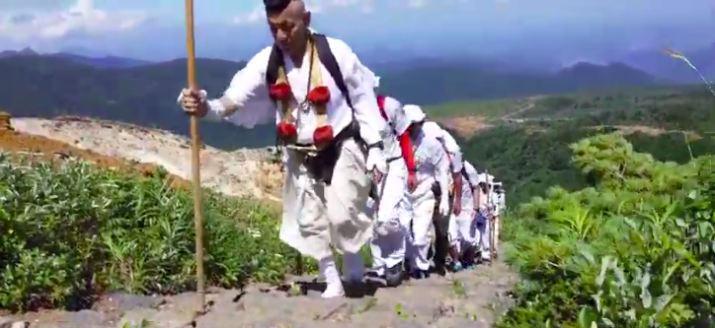 Tatsumi guides members of the Zao Kodo Kai along the Zao Kodo. Image courtesy of Zao Kodo Kai
Tatsumi guides members of the Zao Kodo Kai along the Zao Kodo. Image courtesy of Zao Kodo KaiInspiration and first revival talks
After the Great Tohoku Earthquake on 11 March 2011, which devastated the Tohoku coastline with a powerful tsunami and resulted in a nuclear meltdown at Fukushima, Tatsumi returned to Miyagi Prefecture. His Miyagi acquaintances had requested him to conduct a goma fire ritual and to pray with the locals for the recovery of Tohoku.
After the goma ritual, some Zao locals approached Tatsumi and told him that they were interested in reviving the Shugendo tradition on Mount Zao. They talked about the possibility of a rival and sought his advice.
From the conversation, Tatsumi understood that they did not have any knowledge about, or experience of, Shugendo; they just had a “feeling” and Tatsumi decided that “their blood knows” about the past. They also did not know about Zao Gongen, a major Shugendo deity that is worshipped on Mount Yoshino. They had not yet made a connection between Zao, the name of their mountain range and town, and the Shugendo deity Zao Gongen.
When they watched Tatsumi conduct the fire ritual, during which a prayer to Zao Gongen was chanted, “something clicked” and they thought that Zao Gongen was the key in the search for their roots. This is when they approached Tatsumi and started a discussion about Zao and Shugendo.
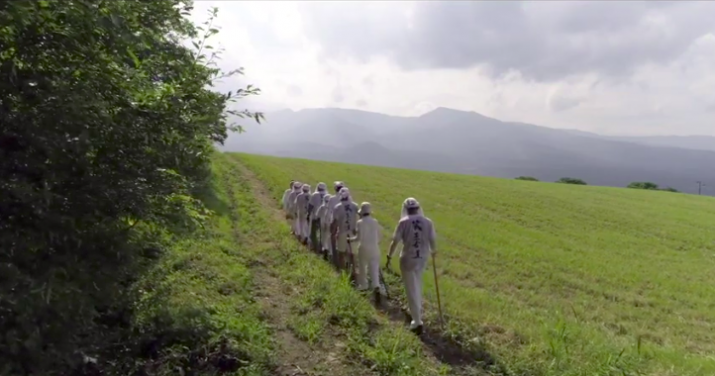
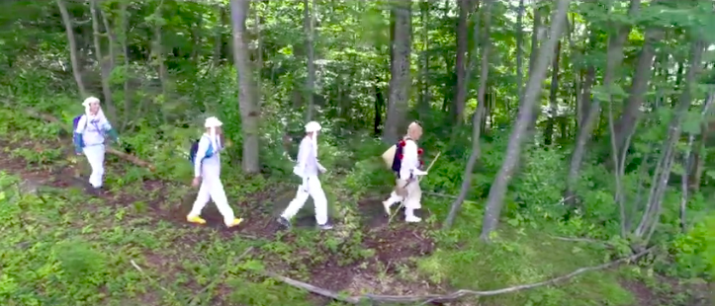 Walking the Aosa Kodo again, an old pilgrimage trail on Mount Zao that has been renovated in recent years. Image courtesy of Zao Kodo Kai
Walking the Aosa Kodo again, an old pilgrimage trail on Mount Zao that has been renovated in recent years. Image courtesy of Zao Kodo KaiFirst step: fixing the trails
After this they took Tatsumi to the top of the mountain by car to Kattamine Shrine. This shrine was the destination of the old pilgrimage trails, but after a road to the shrine was built, people stopped walking the mountain trails and instead drove by car. Gradually, the pilgrimage trails were forgotten and fell into disrepair.
The old mountain trails around Mount Zao had been disused for many years and the revival initiators understood that they needed to restore the pilgrimage trails as a first course of action.
In 2017, Endo Yuichi visited Sakuramotobou temple. He informed Tatsumi that the trails had been repaired and were once agein ready for pilgrims to walk, and that they wanted Tatsumi to walk with them. It would take another three years until this walk took place.
Second step: organizing
The Zao Kodo Kai is a group of local people from the Zao area who have come together for the purpose of rebuilding the Shugendo tradition on Mount Zao. The leader of the group is Endo Yuichi, the owner of a café. In 2020, he also became a town counsellor in order to facilitate the revival.
Sakai Yosuke, in his 40s, works at a tourism agency in Zao Onsen. He is one of the main members of the Zao revival organization. Early in 2020, he visited Sakuramotobou temple and introduced several other members of the association. He also repeated the Zao revival team’s wish to walk the renovated Zao Kodo trails with Tatsumi.
Initially the group was small, but more and more locals have since joined. They include the owners of shops and restaurants, cafés and hotels, professional mountain guides, representatives from local tourism offices, and the mayor of Zao town.
The Shinto priest from Kattamine Shrine cooperates with the revival efforts, but none of the group members were Buddhist monks and none of them had any prior experience as Shugendo practitioners.
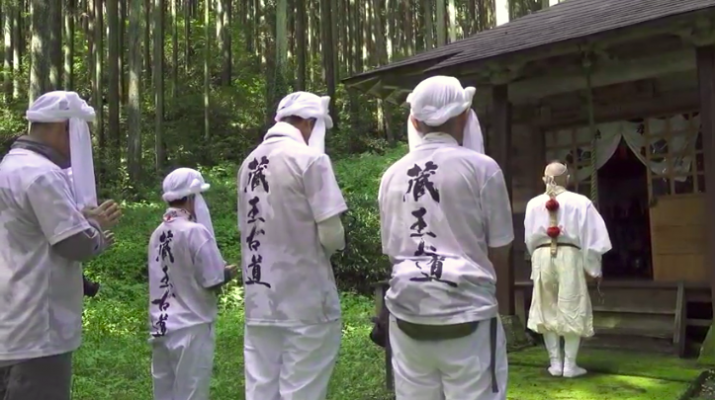 Members of the Zao Kodo Kai wear their new pilgrimage “uniform” during their first pilgrimage with Sendatsu (pilgrimage guide) Ryounin Tatsumi from Mount Yoshino. Image courtesy of Zao Kodo Kai
Members of the Zao Kodo Kai wear their new pilgrimage “uniform” during their first pilgrimage with Sendatsu (pilgrimage guide) Ryounin Tatsumi from Mount Yoshino. Image courtesy of Zao Kodo KaiFirst pilgrimage on the restored trails
In August 2020, Tatsumi and members of the Zao Kodo Kai walked Zao Kodo and the Aosa Kodo, two of the pilgrimage trails that had been restored. Participating group members included women and men, younger and older people, all of whom had prepared by training their bodies and by studying the Shugendo tradition.
The Zao Kodo Kai members wore newly designed Zao Kodo T-shirts for their first pilgrimage. The shirts are now the “official” outfit of the Zao Kodo Kai: white with the name “Zao Kodo” in Roman letters on the front and in Japanese kanji on the back.
White is the traditional color for pilgrimage outfits in Japan, representing purity. But it also symbolizes death because the pilgrimage is seen as a journey of death and rebirth. They also wore long white towels around their foreheads, in the traditional style of headwear during a pilgrimage in the Tohoku area.
Tatsumi was the only person to wear a formal Shugendo monk’s uniform.
The group walked the trails and performed gongyo (prayers) at each sacred place, such as small shrines and stone monuments with spiritual significance. Tatsumi would lead the rituals and recited all the prayers. The participants joined in when they could.
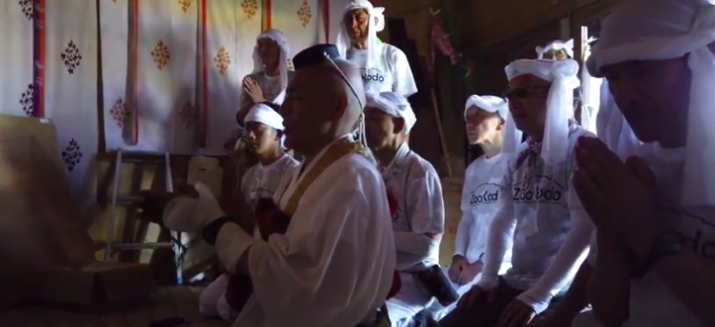 Tatsumi chants prayers inside a small temple along the Aosa Kodo, while members of the Zao Kodo Kai listen. Image courtesy of Zao Kodo Kai
Tatsumi chants prayers inside a small temple along the Aosa Kodo, while members of the Zao Kodo Kai listen. Image courtesy of Zao Kodo KaiTatsumi taught the participating members the Yama Nenbutsu: zange zange, rokkon shojo (Repent. Repent. Purify your six senses), a prayer that is commonly chanted by Shugendo practitioners when they climb a mountain trail. This was the only Shugendo practice that he taught them during this first walk.
The Zao Fudoson, a stone statue of Fudo Myo-o (Wrathful Wisdom King), is one of the main Shugendo deities and one of the landmarks along the trail where the gongyo was held. Another is a small temple, Gangyo-ji, which the locals have been taking care of over the centuries. They did not know that Gangyo is also the name of the uncle of En no Gyoja, the founder of Shugendo.
At the entrance to the trail, and now spanning the width of the road, stands a large red torii, the distinctive gate that marks the entrance to a Shinto shrine. The large plate on top reads: Zao Daigongen O-torii. The destination of the walk was Kattamine Shrine Okumiya (Innermost Shrine), previously called Zao Gongen Shrine, which sits at a high point overlooking the Okama crater lake.
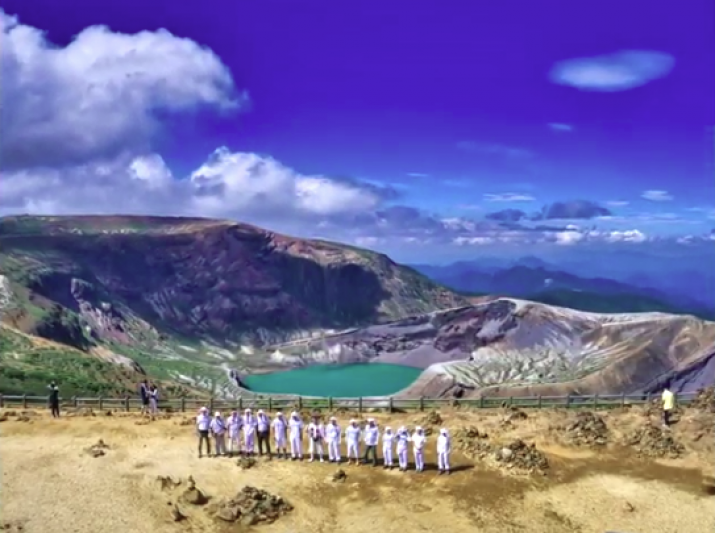 The destination of the pilgrimage along the Zao Kodo is the Okama crater lake. Image courtesy of Zao Kodo Kai
The destination of the pilgrimage along the Zao Kodo is the Okama crater lake. Image courtesy of Zao Kodo KaiThe next step: Shugendo education
The Zao Kodo Kai asked Tatsumi to give some lectures and hold a seminar to teach the members about the basics of Shugendo, about the founder, En no gyoja, and about the “Shugendo spirit.”
They appear to be mostly interested in En no Gyoja, a legendary figure who is said to have lived in the seventh century in the Kansai area, near Mount Yoshino. He is also said to have opened many mountains around Japan for ascetic training.
The members of the Zao Kodo Kai now believe that En no gyoja came all the way from Mount Yoshino to Mount Zao and opened the mountains in their local area for ascetic practices. They view this as a “truth that lives on forever,” despite the disruption that Shugendo experienced during the Meiji period about 150 years ago.
They mentioned to Tatsumi that “knowing the roots and the origin of their hometown would make their community stronger. It would make people prouder of their village, and it would make the bond with Mount Yoshino stronger.”
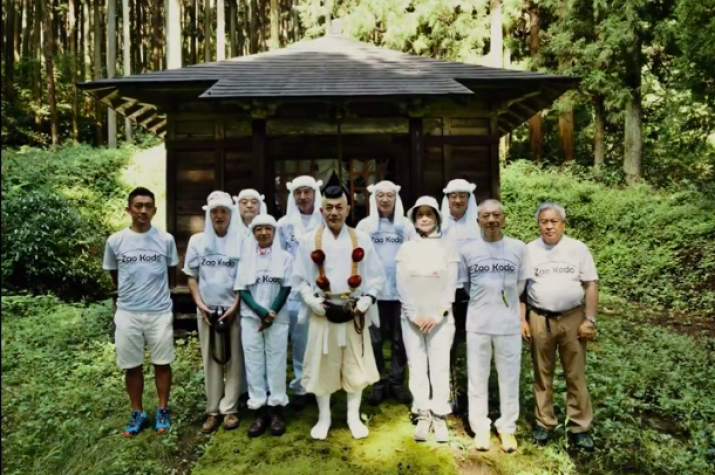 Members of the Zao Kodo Kai include women and men from the Zao area. Tatsumi from Mount Yoshino, center, wears his Shugendo uniform for the pilgrimage. Image courtesy of Zao Kodo Kai
Members of the Zao Kodo Kai include women and men from the Zao area. Tatsumi from Mount Yoshino, center, wears his Shugendo uniform for the pilgrimage. Image courtesy of Zao Kodo KaiSetting a sign: official instalment of Zao Gonen
Now that the pilgrimage trails have been restored, a core group of Shugendo revival participants has been formed and branded “Zao Kodo,” the next step is to raise funds for a large metal statue of Zao Gongen, to be placed on top of Mount Zao. This is similar to the statue of Shakyamuni Nyorai, the historical Buddha, that was placed on top of Mount Shakka, one of the many peaks on the Okugake ascetic training trail on the Kii Peninsula.
The Zao Kodo Kai has already commissioned Tatsumi to conduct a goma fire ritual in front of the new Zao Gongen statue once it is erected in 2021 or 2022.
The future
For now, the members of the revival group want to focus on walking the Zao Kodo trails as often as possible, together with a trained gyoja—ideally a monk from an official Shugendo temple. They hope that Tatsumi will come to Miyagi and walk the pilgrimage trails with them every year.
By being seen on the trail and talking about their walks, the members hope to reach a wider audience. They want to let the local people and visitors know that the Zao Kodo, the old Shugendo pilgrimage trails on Mount Zao, have been revived. They believe that for their revival efforts to be successful, “a connection with many people and a passion for revival” are most needed.
The members of the Zao Kodo Kai do not aim to learn any Shugendo rituals, such as the goma fire ritual, themselves. However, they strongly hope that there will be a person from the Zao region who wants to become a gyoja, a Shugendo practitioner.
Because: “Who passes the Shugendo traditions on to the next generations? Gyoja do!”
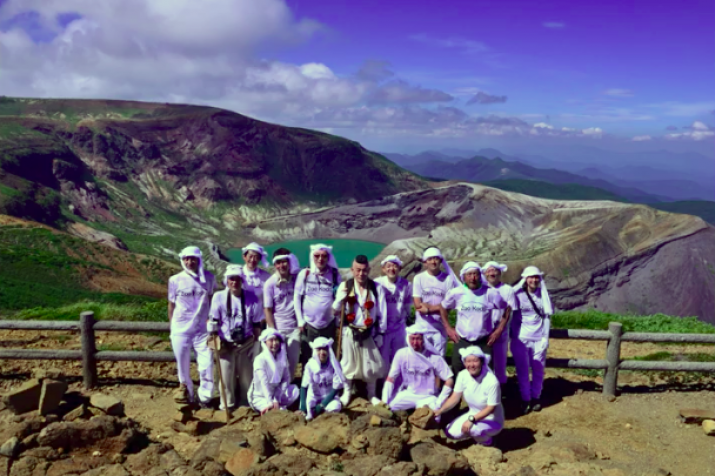 Exhausted but happy at the end of the first Zao Kodo pilgrimage, after instigating the Zao Shugendo revival. Image courtesy of Kodo Kai
Exhausted but happy at the end of the first Zao Kodo pilgrimage, after instigating the Zao Shugendo revival. Image courtesy of Kodo KaiRelated features from Buddhistdoor Global
Connecting the Past and Present of Shugendo – The Revival of Japan’s Ancient Mountain Ascetic Tradition, Part One
Connecting the Past and Present of Shugendo – The Revival of Japan’s Ancient Mountain Ascetic Tradition, Part Two
Connecting the Past and Present of Shugendo – The Revival of Japan’s Ancient Mountain Ascetic Tradition, Part Four
Connecting the Past and Present of Shugendo – The Revival of Japan’s Ancient Mountain Ascetic Tradition, Part Five














